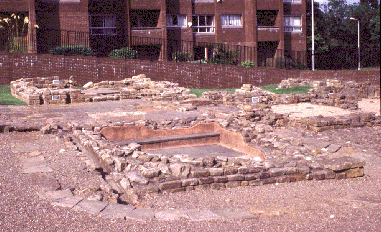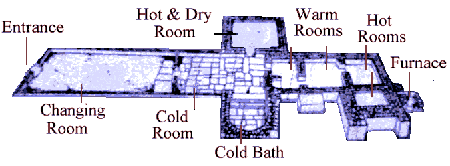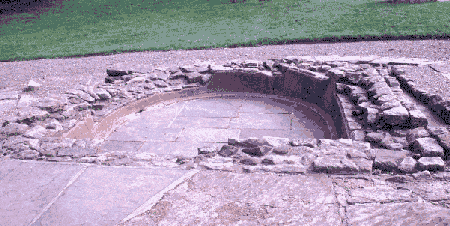Get
a free trial issue of Athena Review
Order a back issue
of Athena Review
Athena Review Vol.1, no.1
The Roman Fort and Bath at Bearsden, Scotland
 Located at the
western end of the Antonine Wall, the Roman fort in this town near Glasgow,
Scotland was occupied between AD 142 and 165. The Bearsden fort covered 2.4
acres (0.9 ha.), which included administrative and storage buildings, graneries,
workshops, barracks, and a bath complex. The site has yielded sculpture and
inscriptions, the latter showing that the fort was built by the Twentieth
Roman Legion.
Located at the
western end of the Antonine Wall, the Roman fort in this town near Glasgow,
Scotland was occupied between AD 142 and 165. The Bearsden fort covered 2.4
acres (0.9 ha.), which included administrative and storage buildings, graneries,
workshops, barracks, and a bath complex. The site has yielded sculpture and
inscriptions, the latter showing that the fort was built by the Twentieth
Roman Legion.
Fig.1: Bathhouse at Bearsden, with cold plunge bath in the
foreground. In back are the cold room (frigidarium), hot and dry room,
or sweatbath (sudatorium), and tepidaria or warm rooms (photo:
Athena Review).]
 Most of the
site lay only 30 cm. underground, yet was largely undisturbed by
extensive Victorian building on the property. While part of the site
is now overlain by modern apartments, the bath complex was excavated in 1973-1979
and is well displayed, with easy access from a street aptly named Roman Road.
Most of the
site lay only 30 cm. underground, yet was largely undisturbed by
extensive Victorian building on the property. While part of the site
is now overlain by modern apartments, the bath complex was excavated in 1973-1979
and is well displayed, with easy access from a street aptly named Roman Road.
[Fig.2: Plan of the Roman bath house at Bearsden
(based on site display).]
 The bathhouse
contained all major components of a second century Roman bath. These included
a changing room (apodyterium); a cold room (frigidarium) and
cold plunge bath; two warming rooms (tepidaria); a hot dry room, or
sweatbath (sudatorium); and a hot room (caldarium).
The bathhouse
contained all major components of a second century Roman bath. These included
a changing room (apodyterium); a cold room (frigidarium) and
cold plunge bath; two warming rooms (tepidaria); a hot dry room, or
sweatbath (sudatorium); and a hot room (caldarium).
[Fig.3: The cold plunge bath at Bearsden. (photo: Athena
Review).]
The warm and hot rooms were heated from below by hot air from a furnace,
circulated through cavities in the walls and a subfloor system of heat ducts
(hypocausts), made in this case of stone slabs rather than the more
typical ceramic pipes. While most of the bathhouse was built of stone, two
of the rooms, the apodyterium (changing room) and the
frigidarium (cold room) were made of timber, like many of the other
fort buildings.
Artifacts and inscriptions from Bearsden are now in the Hunterian Museum
at the University of Glasgow. Nearby are two well-preserved sections of the
Antonine wall, located at the
Hillfoot Cemetery about
a mile from the baths.
[References: Keppie, Lawrence. Scotland's Roman Remains. Glasgow,
1986, 1990.]
Athena Review Image
Archive™ |
Guide to Archaeology
on the Internet |
Paleoanthropology in the
News | Free Issue
Main index of Athena
Review |
Subject Index
| Travel
Pages |
Galleries and
Museums |
Ad
rates |
Current issue
index
Copyright © 1996-2001 Athena
Publications, Inc. (All Rights Reserved).
 Located at the
western end of the Antonine Wall, the Roman fort in this town near Glasgow,
Scotland was occupied between AD 142 and 165. The Bearsden fort covered 2.4
acres (0.9 ha.), which included administrative and storage buildings, graneries,
workshops, barracks, and a bath complex. The site has yielded sculpture and
inscriptions, the latter showing that the fort was built by the Twentieth
Roman Legion.
Located at the
western end of the Antonine Wall, the Roman fort in this town near Glasgow,
Scotland was occupied between AD 142 and 165. The Bearsden fort covered 2.4
acres (0.9 ha.), which included administrative and storage buildings, graneries,
workshops, barracks, and a bath complex. The site has yielded sculpture and
inscriptions, the latter showing that the fort was built by the Twentieth
Roman Legion.
 Most of the
site lay only 30 cm. underground, yet was largely undisturbed by
extensive Victorian building on the property. While part of the site
is now overlain by modern apartments, the bath complex was excavated in 1973-1979
and is well displayed, with easy access from a street aptly named Roman Road.
Most of the
site lay only 30 cm. underground, yet was largely undisturbed by
extensive Victorian building on the property. While part of the site
is now overlain by modern apartments, the bath complex was excavated in 1973-1979
and is well displayed, with easy access from a street aptly named Roman Road.
 The bathhouse
contained all major components of a second century Roman bath. These included
a changing room (apodyterium); a cold room (frigidarium) and
cold plunge bath; two warming rooms (tepidaria); a hot dry room, or
sweatbath (sudatorium); and a hot room (caldarium).
The bathhouse
contained all major components of a second century Roman bath. These included
a changing room (apodyterium); a cold room (frigidarium) and
cold plunge bath; two warming rooms (tepidaria); a hot dry room, or
sweatbath (sudatorium); and a hot room (caldarium).